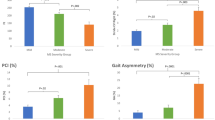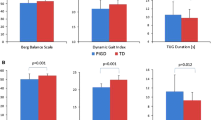Abstract
To identify gait and balance measures that are responsive to change during the timeline of a clinical trial in Friedreich ataxia (FRDA), we administered a battery of potential measures three times over a 12-month period. Sixty-one ambulant individuals with FRDA underwent assessment of gait and balance at baseline, 6 months and 12 months. Outcomes included GAITRite® spatiotemporal gait parameters; Biodex Balance System Postural Stability Test (PST) and Limits of Stability; Berg Balance Scale (BBS); Timed 25-Foot Walk Test; Dynamic Gait Index (DGI); SenseWear MF Armband step and energy activity; and the Friedreich Ataxia Rating Scale Upright Stability Subscale (FARS USS). The standardised response mean (SRM) or correlation coefficients were reported as effect size indices for comparison of internal responsiveness. Internal responsiveness was also analysed in subgroups. SenseWear Armband daily step count had the largest effect size of all the variables over 6 months (SRM = −0.615), while the PST medial–lateral index had the largest effect size (SRM = 0.829) over 12 months. The FARS USS (SRM = 0.824) and BBS (SRM = −0.720) were the only outcomes able to detect change over 12 months in all subgroups. The DGI was the most responsive outcome in children, detecting a mean change of −2.59 (95% CI −3.52 to −1.66, p < 0.001, SRM = −1.429). In conclusion, the FARS USS and BBS are highly responsive and can detect change in a wide range of ambulant individuals with FRDA. However, therapeutic effects in children may be best measured by the DGI.





Similar content being viewed by others
Data Availability
Data not published within this article will be shared after approval by the Friedreich’s Ataxia Research Alliance, USA, and ethics review boards.
References
Bidichandani SI, Delatycki MB. Friedreich Ataxia. In: Adam MP, Pagon RA, Bird TD, Dolan CR, Stephens K, editors. GeneReviewsTM. Seattle: University of Washington; 2017.
Pandolfo M. Friedreich ataxia: the clinical picture. J Neurol. 2009;256 Suppl 1:3–8.
Blair IA, Farmer J, Hersch S, et al. The current state of biomarker research for Friedreich’s ataxia: a report from the 2018 FARA biomarker meeting. Future Sci OA. 2019;5:FSO398.
Wilson CL, Fahey MC, Corben LA, et al. Quality of life in Friedreich ataxia: what clinical, social and demographic factors are important? Eur J Neurol. 2007;14:1040–7.
Ejaz R, Chen S, Isaacs CJ, et al. Impact of mobility device use on quality of life in children with Friedreich ataxia. J Child Neurol. 2018;33:397–404.
Fahey MC, Corben LA, Collins V, Churchyard AJ, Delatycki MB. The 25-foot walk velocity accurately measures real world ambulation in Friedreich ataxia. Neurology. 2007;68:705–6.
Milne SC, Murphy A, Georgiou-Karistianis N, Yiu EM, Delatycki MB, Corben LA. Psychometric properties of outcome measures evaluating decline in gait in cerebellar ataxia: a systematic review. Gait Posture. 2018;61:149–62.
Ilg W, Synofzik M, Brotz D, Burkard S, Giese MA, Schols L. Intensive coordinative training improves motor performance in degenerative cerebellar disease. Neurology. 2009;73:1823–30.
Ilg W, Schatton C, Schicks J, Giese MA, Schols L, Synofzik M. Video game-based coordinative training improves ataxia in children with degenerative ataxia. Neurology. 2012;79:2056–60.
Stephenson J, Zesiewicz T, Gooch C, et al. Gait and balance in adults with Friedreich’s ataxia. Gait Posture. 2015;41:603–7.
Zesiewicz TA, Stephenson JB, Kim SH, et al. Longitudinal gait and balance decline in Friedreich’s ataxia: a pilot study. Gait Posture. 2017;55:25–30.
Milne SC, Hocking DR, Georgiou-Karistianis N, Murphy A, Delatycki MB, Corben LA. Sensitivity of spatiotemporal gait parameters in measuring disease severity in Friedreich ataxia. Cerebellum. 2014;13:677–88.
Galea CA, Huq A, Lockhart PJ, et al. Compound heterozygous FXN mutations and clinical outcome in Friedreich ataxia. Ann Neurol. 2016;79:485–95.
World Health Organization. International classification of functioning, disability and health: ICF. Geneva: World Health Organization; 2001.
Subramony SH, May W, Lynch D, et al. Measuring Friedreich ataxia: interrater reliability of a neurologic rating scale. Neurology. 2005;64:1261–2.
Rummey C, Corben LA, Delatycki MB, et al. Psychometric properties of the Friedreich Ataxia Rating Scale. Neurol Genet. 2019;5:371.
Schmitz-Hubsch T, du Montcel ST, Baliko L, et al. Scale for the assessment and rating of ataxia: development of a new clinical scale. Neurology. 2006;66:1717–20.
Delatycki MB. Evaluating the progression of Friedreich ataxia and its treatment. J Neurol. 2009;256 Suppl 1:36–41.
Stansfield BW, Hillman SJ, Hazlewood ME, et al. Normalisation of gait data in children. Gait Posture. 2003;17:81–7.
Cachupe WJC, Shifflett B, Kahanov L, Wughalter EH. Reliability of Biodex Balance System measures. Meas Phys Educ Exerc Sci. 2001;5:97–108.
Calabro MA, Lee JM, Saint-Maurice PF, Yoo H, Welk GJ. Validity of physical activity monitors for assessing lower intensity activity in adults. Int J Behav Nutr Phys Act. 2014;11:119.
Marchetti GF, Lin CC, Alghadir A, Whitney SL. Responsiveness and minimal detectable change of the dynamic gait index and functional gait index in persons with balance and vestibular disorders. J Neurol Phys Ther. 2014;38:119–24.
Berg K, Wood-Dauphinee S, Williams JI, Gayton D. Measuring balance in the elderly: preliminary development of an instrument. Physiother Canada. 1989;41:304–11.
Fischer JS, Rudick RA, Cutter GR, Reingold SC. The multiple sclerosis functional composite measure (MSFC): an integrated approach to MS clinical outcome assessment. National MS Society Clinical Outcomes Assessment Task Force. Mult Scler. 1999;5:244–50.
Whitney S, Wrisley D, Furman J. Concurrent validity of the Berg Balance Scale and the Dynamic Gait Index in people with vestibular dysfunction. Physiother Res Int. 2003;8:178–86.
Lynch DR, Farmer JM, Tsou AY, et al. Measuring Friedreich ataxia: complementary features of examination and performance measures. Neurology. 2006;66:1711–6.
Schmitz-Hubsch T, Fimmers R, Rakowicz M, et al. Responsiveness of different rating instruments in spinocerebellar ataxia patients. Neurology. 2010;74:678–84.
Liang MH, Fossel AH, Larson MG. Comparisons of five health status instruments for orthopedic evaluation. Med Care. 1990;28:632–42.
Tomczak M, Tomczak E. The need to report effect size estimates revisited. An overview of some recommended measures of effect size. Trends Sport Sci. 2014;1:19–25.
Bhidayasiri R, Perlman SL, Pulst SM, Geschwind DH. Late-onset Friedreich ataxia: phenotypic analysis, magnetic resonance imaging findings, and review of the literature. Arch Neurol. 2005;62:1865–9.
Rummey C, Farmer JM, Lynch DR. Predictors of loss of ambulation in Friedreich’s ataxia. EClinicalMedicine. 2020;18:100213.
Coulter EH, Miller L, McCorkell S, et al. Validity of the activPAL3 activity monitor in people moderately affected by multiple sclerosis. Med Eng Phys. 2017;45:78–82.
Alinia P, Cain C, Fallahzadeh R, Shahrokni A, Cook D, Ghasemzadeh H. How accurate is your activity tracker? A comparative study of step counts in low-intensity physical activities. JMIR mHealth uHealth. 2017;5:e106.
Biau DJ, Kerneis S, Porcher R. Statistics in brief: the importance of sample size in the planning and interpretation of medical research. Clin Orthop Relat Res. 2008;466:2282–8.
Ilg W, Seemann J, Giese M, et al. Real-life gait assessment in degenerative cerebellar ataxia: toward ecologically valid biomarkers. Neurology. 2020;95:e1199–210.
Haberkamp M, Moseley J, Athanasiou D, et al. European regulators’ views on a wearable-derived performance measurement of ambulation for Duchenne muscular dystrophy regulatory trials. Neuromuscul Disord. 2019;29:514–6.
Alsalaheen B, Haines J, Yorke A, Broglio SP. Reliability and construct validity of limits of stability test in adolescents using a portable force plate system. Arch Phys Med Rehabil. 2015;96:2194–200.
Laessoe U, Grarup B, Bangshaab J. The use of cognitive cues for anticipatory strategies in a dynamic postural control task - validation of a novel approach to dual-task testing. PLoS One. 2016;11:e0157421.
Hausdorff JM. Gait variability: methods, modeling and meaning. J Neuroeng Rehabil. 2005;2:19.
Bauby CE, Kuo AD. Active control of lateral balance in human walking. J Biomech. 2000;33:1433–40.
Brach JS, Berlin JE, VanSwearingen JM, Newman AB, Studenski SA. Too much or too little step width variability is associated with a fall history in older persons who walk at or near normal gait speed. J Neuroeng Rehabil. 2005;2:21.
Brach JS, Studenski S, Perera S, VanSwearingen JM, Newman AB. Stance time and step width variability have unique contributing impairments in older persons. Gait Posture. 2008;27:431–9.
Wuehr M, Schniepp R, Ilmberger J, Brandt T, Jahn K. Speed-dependent temporospatial gait variability and long-range correlations in cerebellar ataxia. Gait Posture. 2013;37:214–8.
Egerton T, Danoudis M, Huxham F, Iansek R. Central gait control mechanisms and the stride length - cadence relationship. Gait Posture. 2011;34:178–82.
Kurz MJ, Heinrichs-Graham E, Becker KM, Wilson TW. The magnitude of the somatosensory cortical activity is related to the mobility and strength impairments seen in children with cerebral palsy. J Neurophysiol. 2015;113:3143–50.
Wuehr M, Schniepp R, Schlick C, et al. Sensory loss and walking speed related factors for gait alterations in patients with peripheral neuropathy. Gait Posture. 2014;39:852–8.
Gouelle A, Leroux J, Bredin J, Megrot F. Changes in gait variability from first steps to adulthood: normative data for the gait variability index. J Mot Behav. 2016;48:249–55.
Roche B, Simon AL, Guilmin-Crepon S, et al. Test-retest reliability of an instrumented electronic walkway system (GAITRite) for the measurement of spatio-temporal gait parameters in young patients with Friedreich’s ataxia. Gait Posture. 2018;66:45–50.
Cattaneo D, Jonsdottir J, Repetti S. Reliability of four scales on balance disorders in persons with multiple sclerosis. Disabil Rehabil. 2007;29:1920–5.
Kraan CM, Tan AHJ, Cornish KM. The developmental dynamics of gait maturation with a focus on spatiotemporal measures. Gait Posture. 2017;51:208–17.
Schwabova J, Zahalka F, Komarek V, et al. Uses of the postural stability test for differential diagnosis of hereditary ataxias. J Neurol Sci. 2012;316:79–85.
Acknowledgements
We wish to thank all the participants who have given their time for this project. The authors would also like to thank the Kingston Centre Physiotherapy Department, Monash Health, Melbourne, and the Clinical Research Center for Movement Disorders and Gait, University of South Florida, Tampa, for their support during the study. We wish to thank Lucretia Campbell and Mary Freeman, University of South Florida Ataxia Research Center, for their assistance with data collection.
Funding
This study was supported by the Friedreich’s Ataxia Research Alliance (USA) (FARA), PTC Therapeutics and Voyager Therapeutics, as a part of FARA's Biomarker Consortium.
Author information
Authors and Affiliations
Contributions
Sarah C Milne, Seok Hun Kim, Anna Murphy, Jane Larkindale, Jennifer Farmer, Eppie Yiu, Nellie Georgiou-Karistianis, Theresa Zesiewicz, Martin B Delatycki and Louise A Corben contributed to the study conception and design. Material preparation and data collection were performed by Sarah C Milne, Seok Hun Kim, Ritchie Malapira, Mary Danoudis, Jessica Shaw, Tyagi Ramakrishnan, Fatemeh Rasouli and Geneieve Tai. Analysis was performed by Sarah C Milne. The first draft of the manuscript was written by Sarah C Milne, and all authors revised the manuscript for intellectual content. All authors read and approved the final manuscript.
Corresponding author
Ethics declarations
Ethics Approval
All procedures performed in studies involving human participants were in accordance with the ethical standards of the institutional and/or national research committee and with the 1964 Helsinki Declaration and its later amendments or comparable ethical standards. This study was approved by the Monash Health Human Research Ethics Committee (15035A) and the USF Institutional Review Board (Pro00021414).
Consent to Participate
All participants (or their parents/guardians if aged under 18 years) provided informed consent as per the Declaration of Helsinki.
Conflict of Interest
This study was sponsored by the Friedreich’s Ataxia Research Alliance (USA) (FARA), PTC Therapeutics and Voyager Therapeutics, as a part of FARA’s Biomarker Consortium. S. C. Milne received a National Health and Medical Research Council of Australia Postgraduate Scholarship (APP1093259). E. M. Yiu is a National Health and Medical Research Council Early Career Fellow (APP 1073323). L. A. Corben is a Medical Research Futures Fund Career Development Fellow (APP1143098). J. Larkindale was employed by the Friedreich’s Ataxia Research Alliance. J. Farmer is employed by the Friedreich’s Ataxia Research Alliance. S. H. Kim, A. Murphy, R. Malapira, M. Danoudis, J. Shaw, T. Ramakrishnan, F. Rasouli, N. Georgiou-Karistianis, G. Tai, T. Zesiewicz and M.B. Delatycki declare they have no financial or non-financial interests to disclose.
Additional information
Publisher's Note
Springer Nature remains neutral with regard to jurisdictional claims in published maps and institutional affiliations.
Supplementary Information
Below is the link to the electronic supplementary material.
Rights and permissions
About this article
Cite this article
Milne, S.C., Kim, S.H., Murphy, A. et al. The Responsiveness of Gait and Balance Outcomes to Disease Progression in Friedreich Ataxia. Cerebellum 21, 963–975 (2022). https://doi.org/10.1007/s12311-021-01348-2
Accepted:
Published:
Issue Date:
DOI: https://doi.org/10.1007/s12311-021-01348-2




